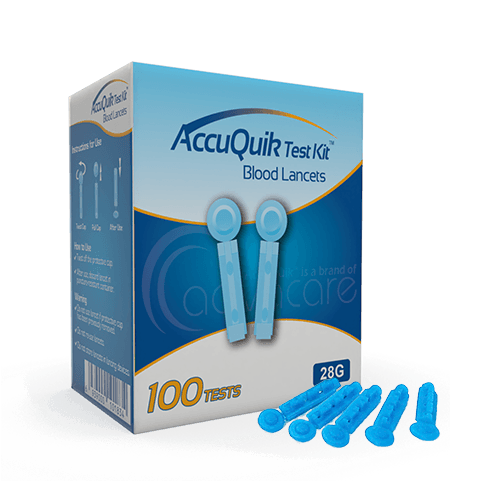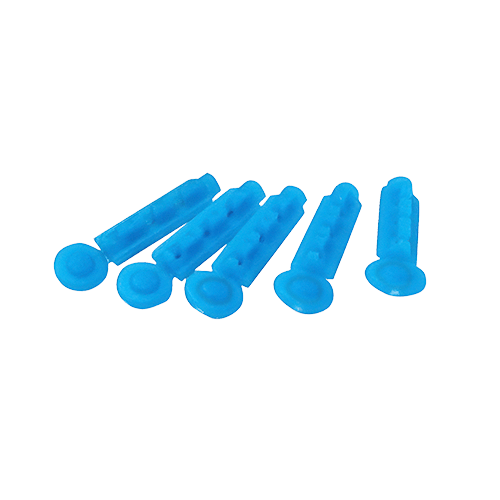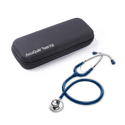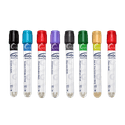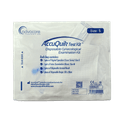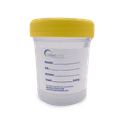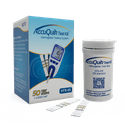- Home›
- Medical Devices›
- Diagnostic Detection Devices›
- Diagnostic Supplies›
- Blood Lancets
Blood Lancets
Type
Needle Size (color-coded)
Packaging
What are Blood Lancets?
Blood Lancets are medical diagnostic tools that are used to collect capillary blood samples. Each blood lancet is designed to create a small and controlled incision in the skin, most often on the fingertip. By puncturing the skin, a small blood sample can be collected for diagnostic testing or monitoring purposes.
Blood lancets are widely used in medical and healthcare settings, including hospitals, clinics, and in the home. They can be utilized for many diagnostic and screening tests that require a small amount of blood, including glucose monitoring, cholesterol testing, and hemoglobin testing. Moreover, they offer a convenient and relatively painless method of blood collection.
Blood lancets are also known by the name of fingerstick devices or lancet devices. They are sterile and disposable items that are designed for one-time use. Each lancet features a small sharp needle or blade, and they are available in 5 different sizes: 30G, 28G, 26G, 23G, and 21G.
AdvaCare Pharma is the exporter and manufacturer of Blood Lancets. These devices are produced in facilities situated strategically worldwide, which allows for better control of the supply chain. Our ISO and CE-certified manufacturing sites undergo regular inspections to ensure strict adherence to international standards.
Product Specifications
Type
Twist Cap blood lancets are sterile, single-use devices that feature an easy twist cover. The needles are equipped with a tri-bevel tip for maximum comfort.
Twist cap blood lancets are produced in a universal design that fits most lancet devices. Each lancet is individually packaged to ensure the highest level of hygiene and safety.
Safety Lancets are sterile, single-use devices that are packaged individually, which ensures the highest level of hygiene and safety.
Each safety needle is fully shielded and retractable to prevent accidents and reduce needlestick injuries. After use, the lancet is shielded which helps reduce the risk of rescue and prevents exposure to the sharp blade.
Why are we a trusted Blood Lancets manufacturer?
AdvaCare Pharma is an American-owned pharmaceutical company that specializes in manufacturing and distributing reliable medical products, including Blood Lancets and our entire range of diagnostic detection devices. Our company utilizes a unique supplier-distributor relationship that differentiates us from other large-scale medical manufacturers.
Over the past 20 years, AdvaCare Pharma has cultivated a strong reputation as a leading pharmaceutical distributor across 65 regions. Our well-established worldwide network includes distributors, hospitals, pharmacies, and many other institutions.
Uses
What are Blood Lancets used for?
Blood Lancets are medical instruments utilized in healthcare settings for the collection of capillary blood samples. These lancets are specifically engineered for the extraction of a small, controlled blood sample by creating a precise incision in the skin at the fingertip.
The collected blood samples aid in various diagnostic and monitoring procedures, yielding valuable insights into a patient's health status and expediting timely medical interventions. Blood lancets are extensively employed in clinical settings such as hospitals, clinics, and laboratories, where they are instrumental in conducting diagnostic tests for conditions like diabetes, hyperlipidemia, and anemia.
How are Blood Lancets used in blood sampling?
Yes, blood Lancets are used in the process of blood sampling and this is a reliable method for obtaining capillary blood samples from patients. The procedure involves the use of a lancet device, which securely holds the lancet for controlled penetration of the skin to obtain a blood sample:
- To begin the process, the lancet is inserted into the lancet device, checking that the needle is properly secured.
- The selected puncture site, often the fingertip, is then cleaned with an antiseptic wipe to minimize the risk of infection.
- Once prepared, the lancet device is positioned against the skin at the desired location, and with a quick, gentle motion, the lancet is triggered to create a small incision.
- The lancet device is then carefully removed, allowing the blood to flow naturally from the puncture site.
- The resulting blood droplet can be collected using a capillary tube, transferred onto a test strip, or directly applied to a diagnostic device for analysis.
What sizes of Blood Lancets are available?
Blood Lancets are available in a range of sizes, each characterized by a specific gauge that corresponds to the diameter of the lancet needle. Commonly available lancet sizes include 30G, 28G, 26G, 23G, and 21G, each possessing distinct advantages and applications based on patient characteristics and sampling requirements.
Thinner lancets, such as 30G, are suitable for individuals with sensitive skin or those requiring frequent blood sampling, as they minimize pain and trauma during the procedure. Conversely, thicker lancets, such as 21G, are preferred for patients with tougher or calloused skin, providing sufficient blood flow for testing purposes.
Healthcare professionals carefully consider factors such as patient age, skin thickness, and the intended use of the blood sample when selecting the appropriate lancet size, thereby maximizing sampling efficiency and patient comfort.
How should used Blood Lancets be disposed of?
Adequate disposal of used Blood Lancets is mandatory to minimize the risk of needlestick injuries, prevent the transmission of infectious diseases, and encourage compliance with healthcare waste management regulations. After performing a blood sampling procedure, healthcare professionals must follow established protocols for the safe disposal of used lancets.
The first step involves immediately placing the used lancet into a designated sharps container specifically designed for medical waste disposal. These containers are constructed of puncture-resistant materials to prevent accidental needlestick injuries and leakage of contaminated fluids.
Avoid recapping or manually handling used lancets to minimize the risk of needlestick injuries. Once the sharps container reaches its designated fill level or requires disposal, it should be securely sealed and disposed of according to local regulations governing medical waste management.
Adhering to disposal practices, healthcare facilities and individuals can then mitigate potential hazards associated with used lancets, protect healthcare workers and the community from exposure to bloodborne pathogens, and contribute to environmental sustainability through responsible waste management practices.
How do Blood Lancets advance patient care in medical environments?
Blood Lancets advance patient care within medical environments through the collection of capillary blood samples for diagnostic testing and monitoring purposes. These lancets enable healthcare professionals to obtain blood samples quickly and efficiently, allowing for timely assessment of various health parameters such as glucose levels, lipid profiles, and hematocrit levels.
With their minimally invasive method for blood collection, blood lancets minimize patient discomfort and anxiety associated with venipuncture, making them particularly suitable for use with pediatric patients, elderly individuals, and those with needle phobias.
In addition to diagnostic testing, blood lancets are used in therapeutic monitoring, allowing healthcare workers to assess treatment efficacy and adjust medication regimens as needed.
Blood lancets empower patients to actively participate in their healthcare through self-monitoring of blood glucose levels, thus leading to timely adjustments to insulin dosages or dietary interventions.
Blood lancets contribute to better patient care outcomes by permitting accurate diagnosis, monitoring, and management of various medical conditions in both clinical and home healthcare settings.
What safety features do Blood Lancets have that minimize the risk of needlestick injuries?
Blood Lancets are designed with various safety features to minimize the risk of needlestick injuries and protect the safety of healthcare professionals and patients. One common safety feature is the retractable needle mechanism, which automatically retracts the lancet needle into the device's housing after use, preventing accidental needlestick injuries and exposure to contaminated needles.
Blood lancets are equipped with ergonomic grips or textured surfaces to enhance user control and minimize slippage during blood sampling procedures. These safety features not only protect healthcare professionals from needlestick injuries but also instill confidence in patients undergoing blood sampling procedures, leading to a safe and comfortable healthcare environment.
FAQs
How are Blood Lancets used in blood sampling?
They are used to collect capillary blood samples for monitoring or diagnostic testing.
What sizes of Blood Lancets are available?
Blood lancets are available in various gauges, which is a measurement of the diameter of the lancet needle. The size of the lancet may be suitable for different purposes. The right lancet size can help ensure optimal blood flow while also minimizing pain or discomfort. Blood lancets are available in 5 sizes: 30G, 28G, 26G, 23G, and 21G. Thinner lancet sizes, such as 30G, are best used for individuals with sensitive skin, including children. The 26G blood lancet is ideal for individuals with thicker or calloused skin, such as those with diabetes or older adults.
Can Blood Lancets be used for both adults and children?
Yes, blood lancets can be used on both adults and children; however, it is important to consider the age, skin thickness, and individual circumstances when choosing a lancet size. A 30G blood lancet should be used on infants and younger children, while a 26 or 28G lancet is more suitable for adults.
Can Blood Lancets be used with different blood collection methods?
While blood lancets are not typically utilized during venipuncture, they are occasionally used as a complementary tool, such as to create a small puncture in the skin over a vein, which can aid in vein selection before needle insertion.
When should a twist cap or safety lancet be used?
The decision between these two types of products depends on factors such as personal preference, ease of use, safety considerations, and particular requirements for blood sampling.
Are there options to tailor the configurations of your Blood Lancets to suit my requirements?
Yes, we offer customization options for many of our medical devices to accommodate specific user preferences and clinical requirements. We employ agile production methods to increase our manufacturing capability specifically to offer a wider range of specifications that can meet the needs of every market.
References
CDC Guidelines on Blood Glucose Monitoring and Insulin Administration
The CDC provides crucial infection control recommendations for individuals involved in blood glucose monitoring and insulin administration to prevent risks of infection transmission. It emphasizes the importance of not sharing blood glucose meters due to the potential for cross-contamination and infection spread. The CDC advises against using lancets and other devices for more than one person to mitigate the risk of infection outbreaks. Proper cleaning, disinfection, and adherence to manufacturer instructions are essential for safe blood glucose monitoring practices.

You might be interested in...
Why AdvaCare Pharma?
As an industry leader, we are aware of our responsibility to provide affordable and sustainable solutions to improve healthcare worldwide.
